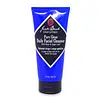What's inside
What's inside
 Benefits
Benefits

 Concerns
Concerns

 Ingredients Side-by-side
Ingredients Side-by-side

Water
Skin ConditioningCocamidopropyl Betaine
CleansingSodium Myreth Sulfate
CleansingDecyl Glucoside
CleansingSodium Chloride
MaskingGlycerin
HumectantPanthenol
Skin ConditioningAloe Barbadensis Leaf Juice Powder
Skin ConditioningMenthol
MaskingAlcohol Denat.
AntimicrobialAcrylates/C10-30 Alkyl Acrylate Crosspolymer
Emulsion StabilisingPEG-90 Glyceryl Isostearate
CleansingPEG-40 Hydrogenated Castor Oil
EmulsifyingSodium Hydroxide
BufferingPolyquaternium-10
Laureth-2
CleansingBenzophenone-4
UV AbsorberPhenoxyethanol
PreservativeMethylparaben
PreservativeEthylparaben
PreservativeLimonene
PerfumingLinalool
PerfumingParfum
MaskingCI 42090
Cosmetic ColorantWater, Cocamidopropyl Betaine, Sodium Myreth Sulfate, Decyl Glucoside, Sodium Chloride, Glycerin, Panthenol, Aloe Barbadensis Leaf Juice Powder, Menthol, Alcohol Denat., Acrylates/C10-30 Alkyl Acrylate Crosspolymer, PEG-90 Glyceryl Isostearate, PEG-40 Hydrogenated Castor Oil, Sodium Hydroxide, Polyquaternium-10, Laureth-2, Benzophenone-4, Phenoxyethanol, Methylparaben, Ethylparaben, Limonene, Linalool, Parfum, CI 42090
Water
Skin ConditioningSodium C14-16 Olefin Sulfonate
CleansingDisodium Cocoamphodiacetate
CleansingAloe Barbadensis Leaf Juice
Skin ConditioningCocamidopropyl Betaine
CleansingSodium Lauroyl Oat Amino Acids
CleansingGlycol Distearate
EmollientPEG-150 Distearate
EmulsifyingHamamelis Virginiana Extract
AntiseborrhoeicGlycerin
HumectantLavandula Angustifolia Extract
Skin ConditioningSalvia Officinalis Leaf Extract
CleansingMatricaria Recutita Flower Oil
PerfumingRosmarinus Officinalis Leaf Oil
MaskingSalvia Officinalis Leaf Oil
Lippia Citriodora Oil
PerfumingPEG-8 Dimethicone
EmulsifyingSodium Chloride
MaskingSodium PCA
HumectantCetyl Alcohol
EmollientCitric Acid
BufferingBenzyl Alcohol
PerfumingDehydroacetic Acid
PreservativeWater, Sodium C14-16 Olefin Sulfonate, Disodium Cocoamphodiacetate, Aloe Barbadensis Leaf Juice, Cocamidopropyl Betaine, Sodium Lauroyl Oat Amino Acids, Glycol Distearate, PEG-150 Distearate, Hamamelis Virginiana Extract, Glycerin, Lavandula Angustifolia Extract, Salvia Officinalis Leaf Extract, Matricaria Recutita Flower Oil, Rosmarinus Officinalis Leaf Oil, Salvia Officinalis Leaf Oil, Lippia Citriodora Oil, PEG-8 Dimethicone, Sodium Chloride, Sodium PCA, Cetyl Alcohol, Citric Acid, Benzyl Alcohol, Dehydroacetic Acid
Ingredients Explained
These ingredients are found in both products.
Ingredients higher up in an ingredient list are typically present in a larger amount.
Cocamidopropyl Betaine is a fatty acid created by mixing similar compounds in coconut oil and dimethylaminopropylamine, a compound with two amino groups.
This ingredient is a surfactant and cleanser. It helps gather the dirt, pollutants, and other impurities in your skin to be washed away. It also helps thicken a product and make the texture more creamy.
Being created from coconut oil means Cocamidopropyl Betaine is hydrating for the skin.
While Cocamidopropyl Betaine was believed to be an allergen, a study from 2012 disproved this. It found two compounds in unpure Cocamidopropyl Betaine to be the irritants: aminoamide and 3-dimethylaminopropylamine. High-grade and pure Cocamidopropyl Betaine did not induce allergic reactions during this study.
Learn more about Cocamidopropyl BetaineGlycerin is already naturally found in your skin. It helps moisturize and protect your skin.
A study from 2016 found glycerin to be more effective as a humectant than AHAs and hyaluronic acid.
As a humectant, it helps the skin stay hydrated by pulling moisture to your skin. The low molecular weight of glycerin allows it to pull moisture into the deeper layers of your skin.
Hydrated skin improves your skin barrier; Your skin barrier helps protect against irritants and bacteria.
Glycerin has also been found to have antimicrobial and antiviral properties. Due to these properties, glycerin is often used in wound and burn treatments.
In cosmetics, glycerin is usually derived from plants such as soybean or palm. However, it can also be sourced from animals, such as tallow or animal fat.
This ingredient is organic, colorless, odorless, and non-toxic.
Glycerin is the name for this ingredient in American English. British English uses Glycerol/Glycerine.
Learn more about GlycerinChances are, you eat sodium chloride every day. Sodium Chloride is also known as table salt.
This ingredient has many purposes in skincare: thickener, emulsifier, and exfoliator.
You'll most likely find this ingredient in cleansers where it is used to create a gel-like texture. As an emulsifier, it also prevents ingredients from separating.
There is much debate on whether this ingredient is comedogenic. The short answer - comedogenic ratings don't tell the whole story. Learn more about comegodenic ratings here.
The concensus about this ingredient causing acne seems to be divided. Research is needed to understand if this ingredient does cause acne.
Scrubs may use salt as the primary exfoliating ingredient.
Learn more about Sodium ChlorideWater. It's the most common cosmetic ingredient of all. You'll usually see it at the top of ingredient lists, meaning that it makes up the largest part of the product.
So why is it so popular? Water most often acts as a solvent - this means that it helps dissolve other ingredients into the formulation.
You'll also recognize water as that liquid we all need to stay alive. If you see this, drink a glass of water. Stay hydrated!
Learn more about Water